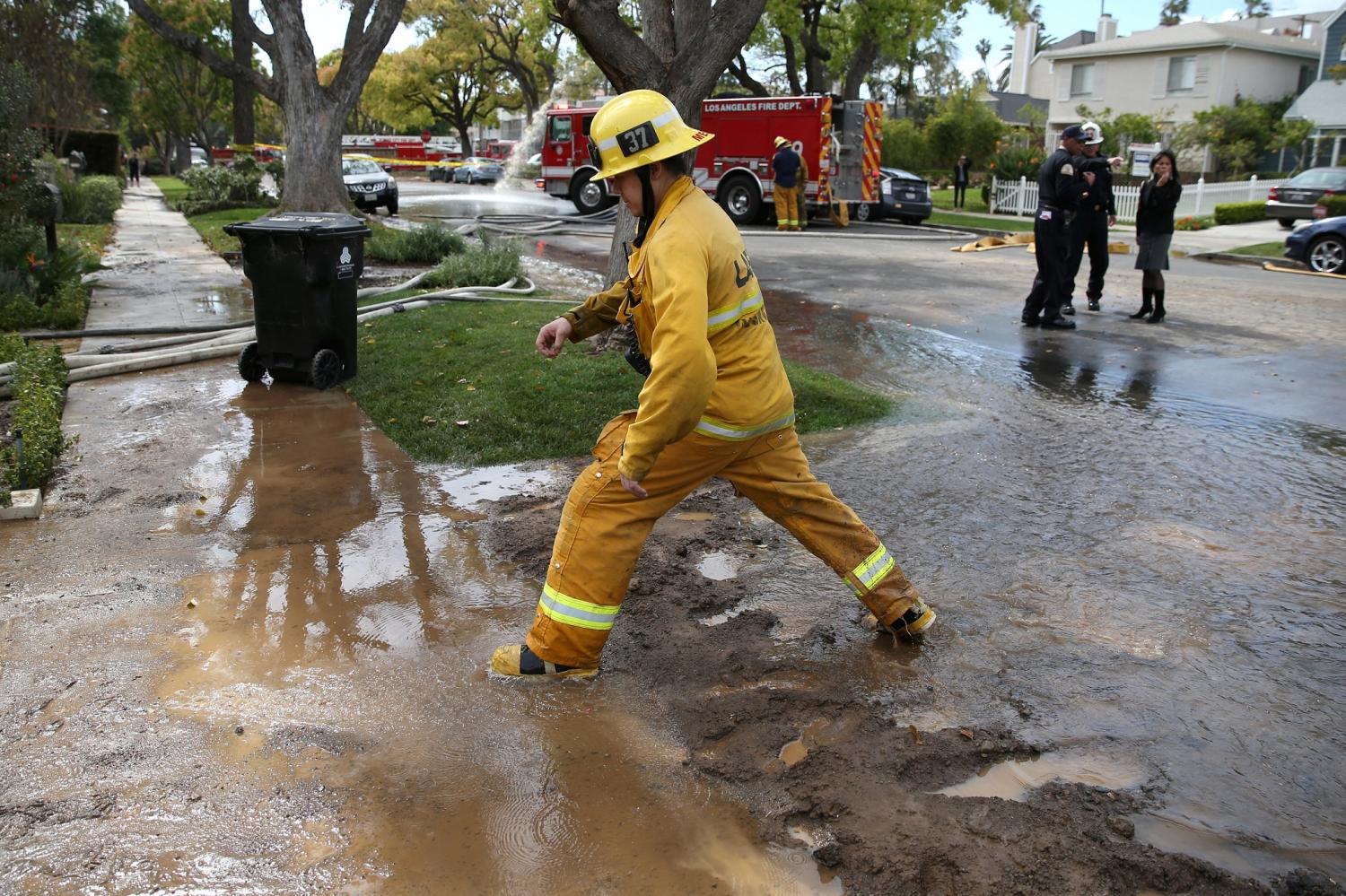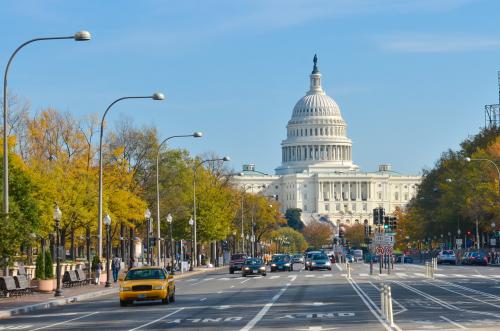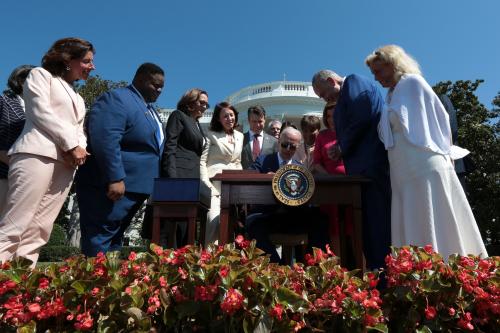Contents
- Understanding the stormwater investment challenge and opportunity
- What do we mean by a resilience marketplace?
- Better define the environmental and economic benefits of more resilient infrastructure
- Develop technical understanding and capacity around new financing tools
- Scale innovation and realize market potential
Climate change is getting harder to ignore, from alarming new reports about its impacts to debates around a Green New Deal. Yet for all this attention, individual places—from the biggest cities to the smallest towns—are still struggling to do something about it.
An unpredictable climate should serve as a strong motivator for every community to better maintain its manmade and natural stormwater infrastructure to be more flexible and responsive. Increased flood risks are among the clearest challenges, with climate change already having generated billions of dollars in flooding costs. But as we saw in Houston during Hurricane Harvey—and in several other places along the Gulf Coast, Mississippi River, and beyond over the past few years—many communities currently have failing systems of water pipes, plants, and natural wetlands. Even more troubling is how communities cannot even handle runoff from daily rainfall, as well as additional pollution.
Communities need a new approach to accelerate investment in infrastructure that is resilient to growing climate pressures. They should carry out proactive repairs of their aging, inefficient stormwater systems as a way to deliver fiscal savings and long-term environmental and economic benefits. They also should invest in new technologies and green infrastructure to better protect properties and improve livability.
Communities need a new approach to accelerate investment in infrastructure that is resilient to growing climate pressures.
To jumpstart resilient investment, however, policymakers must help create a new marketplace for it. Local leaders need to more clearly account for the benefits of resilient infrastructure in order to achieve community (and investor) buy-in. They need a more flexible set of financing tools to pay for upgrades, and room for experimentation to test out new solutions. This brief discusses these considerations in greater depth and lays out several potential areas for future action.
Understanding the stormwater investment challenge and opportunity
Today, the U.S. manages its stormwater infrastructure in relative isolation geographically and programmatically. Utilities and other local public bodies are primarily responsible for addressing stormwater needs, from design and construction to maintenance and oversight of existing systems. Traditionally, they use local resources, primarily from local rate-payers and municipal debt markets, to make investments. But those resources are now frequently stretched to their limit, while communities simultaneously face increasingly costly repairs, growing debt burdens, and environmental mandates. Moreover, outdated procurement processes can make it difficult for communities to consider innovative projects, designs, and partnerships.
In short, the lack of fiscal capacity and innovation within a highly fragmented utility sector has made it difficult to drive widespread stormwater improvements. Instead, maintenance programs are often overly reactive—think emergency crews regularly responding to flooding—and local political leadership too often supports long-term investments only after costly disasters. For its part, the federal government has also traditionally supported relief efforts rather than resilience.
Fortunately, private capital markets are looking for new ways to support climate-related investments. The rise of green bonds, climate bonds, and other forms of green financing signal growing interest in the investor community, particularly among environmental, social, and governance (ESG) investors seeking greater environmental impact. And many of these investors may be willing to accept lower rates of financial return in exchange for enhanced resilience benefits.
But these existing markets have their limits. When it comes to stormwater projects, in particular, investors may not know where to look and utilities may not be nimble enough to consider alternative financing options. Better information exchange and shared learning can help utilities, investors, researchers, and other leaders explore different best practices. Still, a lack of consistency and direction serves to limit smart investment.
In response to the unmet needs of both stormwater system operators and potential investors, we propose that the U.S. develop a new “resilience marketplace” to better connect the shared interests of the two and deliver more proactive investment.
What do we mean by a resilience marketplace?
The creation of a new resilience marketplace goes beyond one single platform or goal; rather, it’s about establishing a new institutional framework that can drive alternative project delivery and financing while increasing overall investment in more resilient infrastructure. The aim should be to create a framework that elevates stormwater infrastructure as an area ripe for alternative investment, particularly additional private investment that can complement and incentivize more widespread public investment.
Several different components, in turn, are essential to the creation of such a marketplace. First, there’s a need to identify what type of governing body would even be responsible for overseeing this marketplace, including federal agencies like the EPA and SEC. Second, there’s a need to set clearer standards and parameters for utilities and investors around what these infrastructure investment opportunities would even look like, including larger collections of stormwater projects across entire regions. Finally, there’s a need to define and certify the benefits in these projects—including improved environmental and economic performance—likely led by a third-party entity and similar to USDA’s organic food standards or LEED standards for buildings.

Developing such a marketplace, though, is easier said than done. It requires a more precise understanding of the gaps—technically, programmatically, or otherwise—that currently separate investors and utilities. These gaps will also vary from region to region. For instance, some utilities may not have a clear assessment of their current stormwater needs while other utilities may lack the staff to consider new technologies, performance measures, and management approaches. Still, many utilities and investors remain hungry for new options, and a clearer framework for additional and alternative investment may lead to a greater volume of projects getting done.
Developing a marketplace requires a more precise understanding of the gaps—technically, programmatically, or otherwise—that currently separate investors and utilities.
To start building this resilience marketplace, we recommend three areas for future action.
Better define the environmental and economic benefits of more resilient infrastructure
Even as stormwater investment gains more national attention, there is a need for standard measures that utilities and investors can use to account for the environmental and economic benefits of these investments. Continued uncertainty around the returns of green infrastructure and other resilience improvements relative to traditional projects not only makes it hard for utilities to try out new designs and approaches, but also scares away potential investors who may consider these investments too uncertain or too risky. Without a standard definition and measurement of the benefits, it’s no surprise that it’s been hard to match-make between investors and infrastructure owners.
Admittedly, many utilities already face the challenge of simply getting their existing infrastructure back to a state of good repair, let alone the task of completing more innovative projects or exploring alternative funding and financing. This is particularly the case for utilities with older combined sewer systems, which can release polluted overflows during a storm and require significant upgrades.
While federal environmental mandates are pushing utilities to reduce these overflows, leaders have an opportunity to reframe this challenge—and other climate pressures, in general—as a way to achieve greater environmental and economic returns. Camden, New Jersey, for instance, has pioneered green infrastructure solutions in this way. As noted in a previous post, doing so can help achieve community consensus on investing in physical and social assets. It’s not just about repairing pipes and creating rain gardens to reduce upfront infrastructure costs; it’s about better quantifying the economic benefits from a more predictable, better-performing built environment over time. Maintaining these systems, after all, requires a well-designed network of infrastructure assets and a well-trained workforce. In turn, heightened property values and improved workforce development are two possible benefits that communities could realize by factoring in a broader range of social assets in future investments that are place-based and not going anywhere else anytime soon.
There are many different types of projects that could conceivably fall under this definition. In addition to green infrastructure, simply improving basic infrastructure assets—like failing pipes—may offer more predictable, long-term benefits as well. While ESG investors may have a greater appetite for large projects that have more extensive (and visible) community benefits, it’s important not to overlook the smaller projects that can deliver gradual (and less visible) benefits to communities over time, too.
As noted before, what is needed now is a formal effort to establish a set list of qualifying resilience benefits, with a particular emphasis on the economic benefits. These should be agreed upon by both the infrastructure owners and investors, requiring some kind of objective entity—whether public, civic, or private—to certify that list. They also should include standard ways to measure the benefits and a third-party system to certify benefits, building off steps already taken by ratings agencies.
If all places and investors can consistently define and measure the benefits from these investments, a common language can foster a common marketplace.
Develop technical understanding and capacity around new financing tools
With a greater emphasis on the physical and social assets at play, communities can begin to expand their vision for future investments beyond traditional funding and financing.
For instance, environmental impact bonds (EIBs) represent a novel way that some utilities, including DC Water, have sought to meet their environmental needs while producing more lasting community benefits. Similar to other types of social impact bonds, EIBs are geared toward a particular purpose (in this case, environmental projects) and appeal to private investors who may be willing to accept lower financial returns to promote broader environmental outcomes. In the case of DC Water, a $25 million EIB was issued to support green infrastructure projects as part of a larger “Clean Rivers” initiative. If the green infrastructure helps reduce flooding more than expected, investors will receive a higher payment, but if it underperforms, DC Water will actually pay out less to investors. EIBs thus enable greater sharing of risks and rewards to accelerate investment in green infrastructure.
The emergence of community-based public private partnerships (CBP3s) has also generated additional interest and investment in more resilient infrastructure. As with other public-private partnerships, CBP3s are a relatively nascent phenomenon, representing a financial arrangement among public entities (like utilities) and private entities to carry out different infrastructure projects, with an additional emphasis on local economic development. One of the few CBP3s in existence is the Clean Water Partnership in Prince George’s County, Md. The County’s Department of Environment and a coalition of private partners, led by a firm called Corvias, agreed to a 30-year contract to improve stormwater facilities and support local hiring and training. In the first three years alone, the partnership invested nearly $100 million to design and construct the facilities, while drawing 40 percent of all workers from local small- and minority-owned businesses.
EIBs and CBP3s are just two possible approaches that show how infrastructure decisionmakers and ESG investors can and will act to support enhanced physical and social assets. But there is more work needed to explore the full range of opportunities, including the potential invention of new investment tools. Ensuring that utilities have the technical and programmatic capacity to consider these alternative approaches is enormously important, too. National organizations and federal agencies must play a central role in providing programmatic and technical guidance as new financing tools emerge over time, including possible support from federal and state loan programs like WIFIA and the SRFs; they can help supply the grease needed to accelerate marketplace activity.
Scale innovation and realize market potential
The limited size and reach of these tools leaves many questions unanswered about their future direction. With stormwater needs continuing to escalate nationally—approaching tens of billions of dollars in years to come—throwing millions of dollars at ad-hoc projects in a few places is not going to deliver sweeping change. Even worse, constantly holding up examples from the same leading places may not always provide the most useful information for other places. It could also limit their interest (or ability) to test new approaches, and leave them feeling further left behind. What’s needed is a clearer look into how social impact investment can address our infrastructure needs more consistently, and how more resilient stormwater projects represent an ideal avenue for future experimentation in more places.
Expanding social impact investment—and realizing the overall market potential—depends on several factors:
- There is a need to clarify the types of actors involved and the roles of these actors; utilities are paramount in this respect, but exploring the wide range of ESG investors matters too.
- Ensuring that there are timely and reliable performance measures to gauge “success” is important for these actors to use in their funding and financing decisions. Reduced flood risks, for instance, are one way to track improved environmental outcomes from more resilient infrastructure investment, but there are fewer consistent indicators to judge community benefits. There needs to be a more standardized menu of benefits that all types of utilities and investors can consider throughout the country.
- Extending lessons to other markets must go beyond a basic understanding of best practices. For example, individual pilot projects can offer some precedent to consider, but utilities and investors must ultimately view projects in a local context, while striving to learn and improve from past successes nationally. Increased interest in infrastructure public-private partnerships in recent years has prompted similar conversations, where regions must tread cautiously. All actors should have access to a common information portal to know about major transactions and relative performance.
The bottom line: communities need to more proactively invest in resilient infrastructure, and the current system is not going to cut it. Without additional experimentation, the country will keep running into the same challenges over and over again: limited fiscal capacity, deferred maintenance, and a lack of interest and action until it’s too late. In some communities, flooding and other climate pressures have become so troublesome that leaders are even considering retreat.
Rather than shying away from the challenge at hand, communities have an opportunity to embrace a new approach to get projects done, while more directly extending the benefits to their local residents and delivering climate-conscious financial returns. Recognizing and establishing a clearer marketplace to drive resilient infrastructure investment would mark a good step in this direction.








